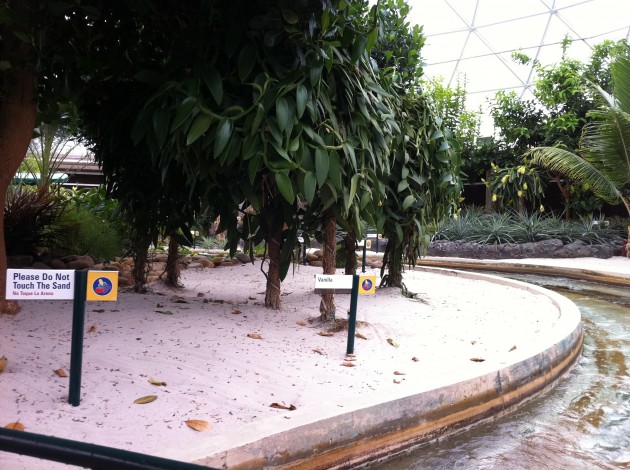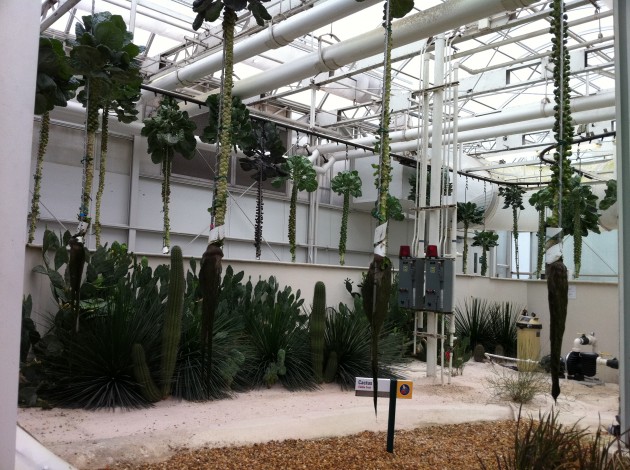One of the coolest, and most thought-provoking, experiences of The Walt Disney World experience thus far is the greenhouse ride at the Living with the Land attraction in Epcot. By focusing on renewable farming techniques and applying best-practices in technology, the researchers and scientists that work in this facility have been able to dramatically increase crop yields in low-soil environments, engineering tomato plants that produce up to 35,000 tomatoes in 16 months, 9 pound lemons, lettuce plants that produce tens of thousands of heads of lettuce, and even fish and alligators.
What I find particularly interesting is the implications for space colonization (no that isn’t a joke). If the facility could ever become self-powering, perhaps with some sort of nuclear reactor, a self-sufficient bio-dome would be entirely possible. There would be adjustments for gravity force that would need to be made. Why aren’t our tax dollars going to research stuff like this? World hunger could be essentially eliminated and mankind’s greatest asset – our combined intellectual capacity – could be freed to focus on other problems, such as engineering and biology.
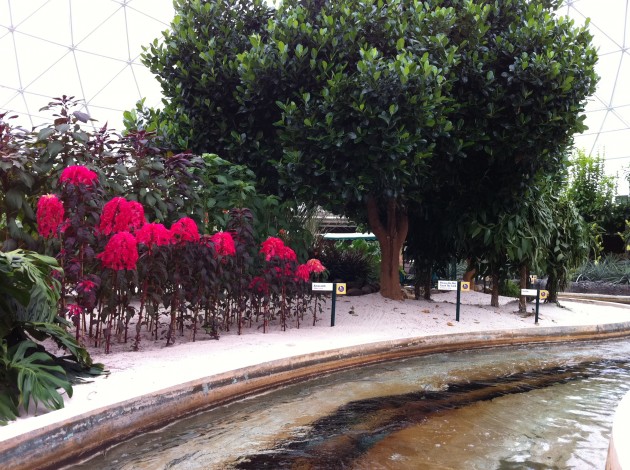
The doors opened and the boat in which we rode made its way on the water canal into a large greenhouse with plants growing on either side of the bank.
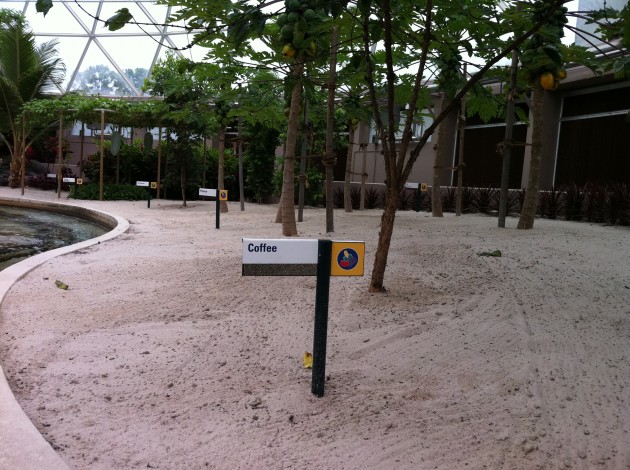
The Epcot Living with the Land greenhouse can grow crops from all over the world regardless of climate, including coffee, cinnamon, vanilla, lemons, peppers, etc.

The entire trip, Aaron has been asserting that Disney is so magical, that somewhere on the property, they are probably growing Miracle Berries, or Miracle Fruit, the magical food that causes your taste bud receptors to switch so that once you've eaten one, the hottest pepper would taste like the sweetest sugar candy. The effect is temporary, of course, but he's been wanting to grow them forever. Sure enough, we round the corner in the boat and Aaron lets out a triumphant, "Ha!" and points. Disney grows Miracle Berries.

The Epcot greenhouse even grew Cacoa, the plant that produces the essential ingredient in chocolate. This place is awesome! You could grow your own coffee, tea, sugar, cinnamon, chocolate ... why aren't all farms like this?
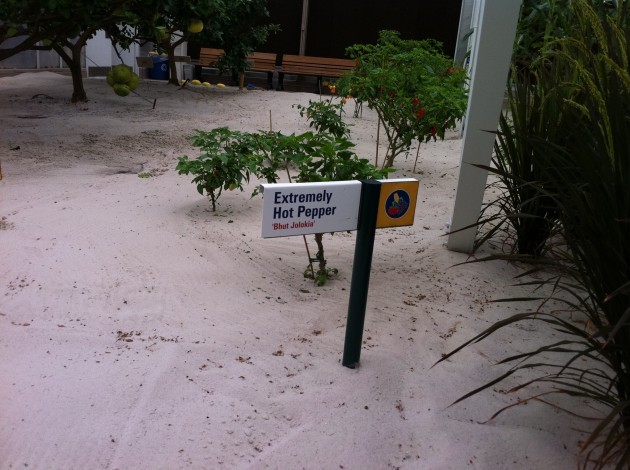
Don't touch this plant - the Bhut Jolokia, or Ghost Pepper or Ghost Chili, is the hottest pepper in the world. It is normally grown in India and rural Sri Lanka, where it is called the Cobra Chili. This chili pepper is 401.5 times hotter than Tabasco sauce. In the past few years, a handful of other chili peppers have been considered hotter (the Dorset Naga and Naga Viper, and Trinidad Scorpion Butch T), but is so powerful, that scientists in India's defense department are researching ways to use the ghost pepper in non-lethal hand grenades as a weapon to force terrorists to surrender. Bombs using the Bhut Jolokia are used to keep wild elephants at a distance as a safety precaution.

A door opens in front of the boat and we are brought into a room where fish are being grown in tanks, farmed just like the lemon trees or tomato plants.

Schools of Tilapia were being grown in the tanks to my right in the greenhouse ... which is, paradoxically, red.

The Disney scientists even work on farming alligators and other animals to prove that mankind could create modern equivalents of Noah's Ark in the event of a natural disaster or the need to preserve a species.

They are able to grow rich alongside corn alongside bananas alongside tomatoes alongside cotton ... it's amazing.

If the world were better organized, food could be grown en masse in skyscraper-like greenhouses, free of disease and plague, at rock-bottom costs to make it more affordable for the world's poor. Would it bankrupt the average farmer? Yes. But they'd find other work (after all, virtually every one reading this had ancestors who were farmers and most of us aren't today). The gain to civilization would be worth that sacrifice if hunger could be eliminated in parts of the world where kids starve to death and life expectancy is under 35 years old.

The tomato trees at Disney were phenomenal. One of the trees (they grow them as trees with minimum soil instead of traditional bushes) produced 35,000 tomatoes in 16 months.

There was another insane statistic regarding the lettuce, which you can see in the distance in the spiral tubes ... something like 15,000 heads of lettuce from a single plant. The tubes provides nourishment that, I presume, is computer-controlled based upon feedback from plant nutrient levels. That is just a guess but I was trying to analyze the wires as we went through the ride and figure out where they went.
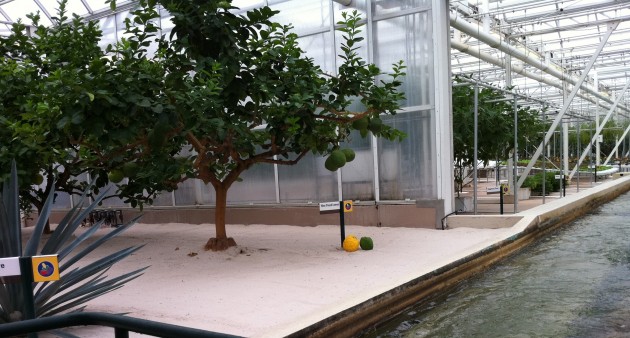
The lemon trees were awesome ... Disney can produce 9 pound lemons from its greenhouse. I have no idea how large a glass of iced tea would need to be to accomodate a 9 pound lemon but it's still fantastic they were able to figure out the process.

We passed what looked like a research lab in the greenhouse. There were also private tours available; the next time we go back, I'm signing up. This whole sustainable-environmentally-friendly-mass-production-of-food interests me.
Why couldn’t the Walt Disney Company create a subsidiary, let’s say Disney Foods, LLC, and begin a prototype greenhouse in the middle of the country, producing enormous quantities of food and selling to suppliers? They would have the resources to compete with an Archer Daniels Midland. If they just wanted to continue their food research, they could create a 501(c)3 instead, Disney Food Pantry, and give all of the harvest away to food banks, while raising donations to hire scientists and researchers. That is the type of thing I would joyfully write a check to support. There is so much to think about here … this is probably going to be one of those “big idea” moments in my life that will result in some action 10 or 20 years from now that will seem like it happened overnight but instead was the result of me thinking this over … it’s just awesome.
[mainbodyad]




